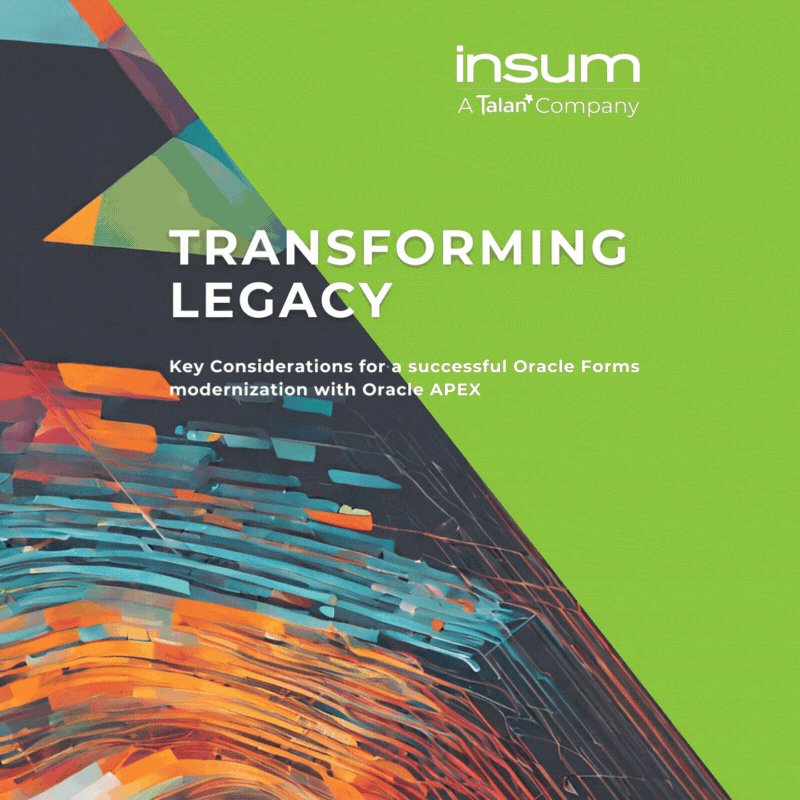Oracle Forms is a widely-used development tool for creating client-server applications. If you’re still using it, you’re certainly not alone.
But as technology and needs evolve, you might be looking for new ways to improve efficiency and user experience. You might, like many others, be considering a migration to Oracle APEX.
Migrating to Oracle APEX can bring many benefits, such as modern user interface, better scalability, enhanced security, and lower costs. However, migrating from Oracle Forms to APEX can also be a complex and time-consuming process.
We’ve got dozens of Oracle Forms migration and modernization projects under our belts. Although each project is unique, we’ve learned that answering a few questions at the start is a surefire way to ensure success.
So if you’ve settled on Oracle APEX for your Oracle Forms replacement or modernization, here are some of the things you should consider. And even if we haven’t yet convinced you that Oracle APEX is ideal for your Oracle Forms migration, you’ll want to read on.
Why do I want to modernize or migrate my Oracle Forms applications?
One of our consultants says we shouldn’t call these applications ‘legacy’, because it’s like calling someone’s baby ugly. Oracle Forms are often the backbone of your organization, and have likely served you well for many years.
Migration projects are rarely simple or straightforward, so they are not to be undertaken lightly. Being very clear on the main drivers of this change will help make the project successful.
Is it to improve security? Scalability? Maintainability? Is it to enable new capabilities or business processes? All of the above?
How you answer this question could have impact on the overall design of your project, as well as project cost. Be very clear on the WHY.
And if you’re curious about the reasons others have for wanting to modernize their Oracle Forms applications, check out the results of a survey we performed during a recent webinar we did:
Do I need to do this project in one single phase?
If you’re staying on the same Oracle database, then you have the option of working in multiple phases without disrupting your production environment.
We call this a hybrid solution, where Oracle APEX and Oracle Forms seamlessly coexist.
Grouping business functions together and creating modules with them is a good idea. Maybe your back office applications are still perfectly suited to your needs for now, but you’re getting pressure from the business to give your clients a web-based portal.
You might be able to start with a business function or two in APEX, and maintain your Oracle Forms application until you’re ready for more.
Migration projects tend to be quite demanding. A phased approach to migration or modernization could end up being a very valuable strategy if you are looking to spread costs over time because of budget constraints. Since APEX lives in the same database and data model, it makes it easier for a phased approach.
Are your users ready for this move?
Don’t underestimate the readiness of your users for 2 reasons:
- They will likely be heavily involved in the conversion process – do they know that? Their input will be crucial for validating business requirements and explaining the actual functionality needed. You will have to plan multiple sessions with them to go through existing system to ensure you fully understand how the system is used, how they expect it to work, and any major features they wish existed.
- You want to get their valuable input on what you will be proposing for modernizing business functions in the new system. Are they ready to move on to something new? Change management will be very important for buy in. The best thing to do is to prepare mock-ups of what you will be developing and then have them participate in meetings where you get their input on what they like and dislike as soon as possible. You don’t want to end up having developed half the system and then have the users criticize what has been done because they were not involved in the process.
Do I take advantage of this project to do enhancements to the actual system?
Yes. You must take advantage of this project to make enhancements. If you are converting your forms towards a new technology this most likely means the actual system was built years ago and therefore is in need of enhancements. As you are already aware, there is no “one to one” conversions when converting to a new technology. So, since you will be doing things differently anyway, you might as well do them with new requirements in mind.
What is the scope of the migration project? Do I know which Forms are not used anymore?
You won’t want waste cycles converting outdated forms, so you need to have this information. This sounds like a simple question, but believe me, you will not get a straight answer from your users. Set up auditing to get statistics about how your users use their Forms. Some functions only get used rarely, so make sure your auditing tool takes this into account.
And speaking of scope, what do I do with my Oracle Reports?
Oracle Reports are often the forgotten child of these conversions. (People often ask us to quote their Forms to APEX conversions, but forget about the reports.) Again, report conversions could be part of a phased approach, and your reports could be converted at a later stage. You will still need your Report server for your reports to continue working until then. Don’t forget, APEX can call existing Oracle Reports quite easily.
Do I have a competent team and sufficient planning?
Effective planning is crucial for a successful migration project. This includes discussions about reports, obsolete forms, and user readiness. Equally important is assembling a team with the right skills and experience. An experienced team or a knowledgeable coach can prove invaluable during the migration process.
Are my current hardware and infrastructure ready for the migration?
Upgrading or migrating software may necessitate changes to your infrastructure. This could mean updating server hardware or increasing network capacity to handle additional load. Now may also be a good time to consider a move to Oracle Cloud Infrastructure.
How will I manage the change in user interface and user experience?
Migrating from Oracle Forms to APEX can present a significant change in user interface and user experience. Planning for user training and support after the migration is crucial to ensuring a smooth transition.
Quick tip:
I recommend that you do a small analysis phase for your reports before doing anything else.
You will determine which reports are not used anymore, what output format to produce them in(interactive, PDF, other), which ones to combine if possible (especially when using interactive reports), do they need to be printed or not, and identify which ones need to be sent in batch.
How much is this going to cost?
To fully understand the effort and costs, what you really need to do is go through the existing system and open each form one by one and go through each canvas, block, field, trigger and program unit of the form, and you will have a good idea of the effort to convert each form.
As you might have guessed, that approach might work for a system with a handful of forms, but what if you have 1,500 forms to convert, as was the case with some of our clients? After facing this problem time and time again, we decided to build a tool to automate the process of evaluating each form, which we constantly refine after each project to improve the accuracy of automated estimations. Now, after many Forms conversions projects behind us, we are able to scope the effort of even very large projects in a matter of hours.
Costs obviously vary with the complexity and number of Forms and Reports in your environment. But development costs can be partially offset by the fact that you will no longer need your Oracle Forms and Reports licenses.
Are there any 3rd party integrations we need to consider?
Not only does your business rely on your Oracle Forms application, it’s also likely connected to other key applications via integrations you might not have fully considered.
Before embarking on your modernization project, make sure you have analyzed and documented any potential interfaces to your Forms application.
The good news is that since your back-end may remain unchanged with APEX, your existing interfaces may not be impacted.
But because modernization projects often do include updates to business functions including the data model, you need to consider these interfaces very early on in the project and include them in your project plan.
Conclusion
In closing, please do not underestimate the following two items:
- You need to plan this project well ahead of time. Some of the questions previously discussed will prompt you to do things before you even start programming like asking yourself what to do with your reports or which forms are obsolete in the current system. You will probably start talking to your users to get a feeling if they are ready for this adventure and what would be a good timing for them.
- You need to assemble a team of people that know what they are doing. Obviously if you can get people who have done this before then you’re in great shape. My guess is that if you are reading this blog that means you haven’t done this before and that you would benefit of having a team like ours to help you out. At the very least get someone that has this experience to coach the team throughout the project
I hope this list of questions was helpful. Please feel free to contact us if you have any questions about an upcoming Oracle Forms migration project. It will be our pleasure to share some real-life experiences.






Quite interesting and helpful. Good startup point.